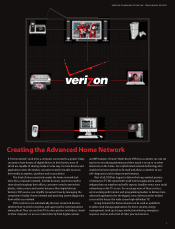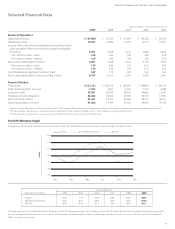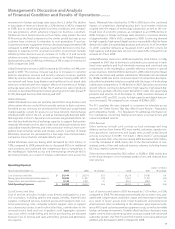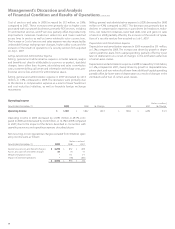Verizon Wireless 2009 Annual Report Download - page 18
Download and view the complete annual report
Please find page 18 of the 2009 Verizon Wireless annual report below. You can navigate through the pages in the report by either clicking on the pages listed below, or by using the keyword search tool below to find specific information within the annual report.
Operating Costs and Expenses
Although our overall operating costs and expenses increased in 2009 as
a result of the acquisition of Alltel, we expect to realize further synergies
in 2010 as we continue the integration of Alltel’s operations. Additionally,
complementary technology standards will facilitate the continuing
integration of Alltel’s network operations, resulting in reduced costs to
operate our network. We expect to continue to achieve reduced adver-
tising expense as a result of completing the conversion of the retained
Alltel customers to the Verizon Wireless brand, and to eliminate duplicate
overhead, facility and headcount expenses. We anticipate that labor costs
will decrease in our Wireline segment as a result of headcount reductions
which will be partially offset by increased content costs for video in our
growth businesses. We also expect earnings will be negatively affected
by non-cash pension and retiree benefit costs in 2010.
Capital Expenditures
Our 2010 capital program includes capital to fund the introduction of
advanced networks and services, including FiOS and LTE, the continued
expansion of our core networks, including our IP and wireless EV-DO
networks, integration activities, maintenance and support for our legacy
voice networks and other expenditures. During 2009, we continued to
develop our wireless LTE network, which we intend to deploy in 25 to 30
markets in 2010 and to cover substantially all of the United States by the
end of 2013. The amount and the timing of the Company’s capital expen-
ditures within these broad categories can vary significantly as a result of
a variety of factors outside our control, including, for example, accelera-
tions or delays in obtaining franchises or material weather events. We are
not subject to any agreement that would constrain our ability to con-
trol our capital expenditures by requiring material capital expenditures
on a designated schedule or upon the occurrence of designated events.
Capital expenditures declined in 2009 compared to 2008. We believe that
we have sufficient discretion over the amount and timing of our capital
expenditures on a company-wide basis that we can reasonably expect
to have capital expenditures in the range of $16.8 billion to $17.2 billion
in 2010. Additionally, we plan to substantially complete the FiOS deploy-
ment program by the end of 2010.
Cash Flow from Operations
We create value for our shareowners by investing the cash flows gener-
ated by our business in opportunities and transactions that support our
strategic imperatives, thereby increasing customer satisfaction and usage
of our products and services. In addition, we use our cash flows to main-
tain and grow our dividend payout to shareowners. Verizon’s Board of
Directors increased the Company’s quarterly dividend 3.3% during 2009.
This is the third consecutive year in which we have raised our dividend,
reflecting the strength of our cash flow and balance sheet. Net cash pro-
vided by operating activities for the year ended December 31, 2009 of
$31.6 billion increased by $4.0 billion from $27.6 billion for the year ended
December 31, 2008.
Other
We do not currently expect that legislative efforts relating to climate
control will have a material adverse impact on our consolidated financial
results or financial condition. We believe there may be opportunities for
companies to increase their use of communications services, including
those we provide, in order to minimize the environmental impact of their
businesses.
CONSOLIDATED RESULTS OF OPERATIONS
In this section, we discuss our overall results of operations and highlight
items that are not included in our business segment results. We have
two reportable segments, which we operate and manage as strategic
business units and organize by products and services. Our segments are
Domestic Wireless and Wireline.
This section and the following “Segment Results of Operations” section
also highlight and describe those items of a non-recurring or non-oper-
ational nature separately to ensure consistency of presentation. In the
following section, we review the performance of our two reportable seg-
ments. We exclude the effects of certain items that management does
not consider in assessing segment performance, primarily because of
their non-recurring or non-operational nature as discussed below and in
the “Other Consolidated Results” and “Other Items” sections. We believe
that this presentation will assist readers in better understanding our
results of operations and trends from period to period.
Corporate, eliminations and other includes unallocated corporate
expenses, intersegment eliminations recorded in consolidation, the
results of other businesses such as our investments in unconsolidated
businesses, lease financing, and other adjustments and gains and losses
that are not allocated in assessing segment performance due to their
non-recurring or non-operational nature. Although such transactions
are excluded from the business segment results, they are included in
reported consolidated earnings. Gains and losses that are not individu-
ally significant are included in all segment results, since these items are
included in the chief operating decision maker’s assessment of segment
performance. Reclassifications of prior period amounts have been made
in accordance with the adoption of the accounting standard on non-
controlling interests in the consolidated financial statements and, where
appropriate, to reflect comparable operating results for the spin-off of
our local exchange and related business assets in Maine, New Hampshire
and Vermont which was completed on March 31, 2008.
16
Management’s Discussion and Analysis
of Financial Condition and Results of Operations continued
























